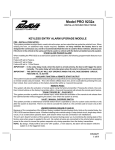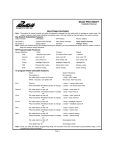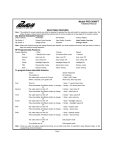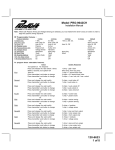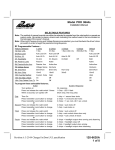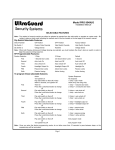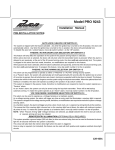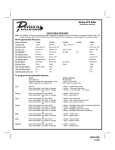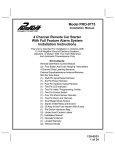Download Audiovox PRO 9232 User's Manual
Transcript
Model PRO 9232 INSTALLATION INSTRUCTIONS KEYLESS ENTRY ALARM UPGRADE MODULE PRE - INSTALLATION NOTES : This system provides an output that is used to drive the siren, and an output that can pulse the vehicle's horn. When utilizing the horn, an additional relay maybe required. Caution: on many vehicles the factory horn is not designed for continuous use, and it is recommended that the siren is used for these vehicles. Check to see if the horn in the vehicle is the same part that is used in a vehicle with the factory installed security system. STAND ALONE PASSIVE ALARM When installing the PRO-9232 as a stand alone passive alarm system, the following programmable features must be set: Feature #5 set to Passive. Feature #7 set to Delay. Feature #8 set to 1 Wire Disarm. IMPORTANT : In the entry delay mode, when the alarm is armed actively, the doors will trigger the alarm instantly. The entry delay will only take place when the alarm is allowed to arm passively! IMPORTANT : THE ENTRY DELAY WILL NOT OPERATE WHEN THE VOLTAGE SENSING CIRCUIT, FEATURE # 6, IS ACTIVE AUXILIARY FUNCTION or REMOTE START OUTPUT This system includes an additional transistorized ground output that can be used to trigger an external remote starter or remote window closure module. This is the Green w/Black trace wire, and it is activated by pressing the Lock, then Unlock, then Lock buttons on the factory transmitter within a 3 second time period. REMOTE PANIC This system will allow the activation of remote panic using the factory transmitter. Pressing the Unlock, the Lock, then Unlock buttons on the factory transmitter within a 3 second time period will activate the remote panic feature. TRUNK TRIGGER BY - PASS INPUT This system provides a positive trunk release input, which allows the activation of the remote trunk release from the OEM transmitter without triggering the alarm, even when the system is armed. VALET / MANUAL OVERRIDE SWITCH This system provides a valet/manual override switch which is operable by use of a custom code override or only after the system is disarmed. There is no need to conceal this switch as the override code is known only to the operator. UNDERSTANDING DISARM #1 AND #2: Because of the complexities of the different factory installed Remote Keyless Entry Units on the market today, the PRO- 9232 uses two disarm inputs. Whether installing into a vehicle using a 2-step unlock circuit, single step unlock circuit, or as a stand alone passive alarm, both disarm wires must be connected in all installations. The arm and disarm functions of this system are learned during power up, by monitoring the resting state of the factory wires when power is applied to the unit. Be certain all wires are connected to the vehicle before applying power to the circuit to insure the system responds only during operation from the factory transmitters. NOTE: By design, if feature #8 is set to the "ON" position, (1 wire disarm), the alarm will not disarm while the system is in the triggered mode. INSTALLATION OF MAJOR COMPONENTS : ALARM CONTROL MODULE Select a mounting location inside the passenger compartment ( up behind the dash ), and secure it using screws, or cable ties. Do not mount the control module in the engine compartment, as it is not waterproof. Do not mount the unit or route the wiring near the steering shaft, as it might become entangled preventing proper operation of the vehicle. L.E.D.& VALET / OVERRIDE SWITCH ASSEMBLY The LED & Valet/Override switch assembly are provided for to facilitate installation. The unit should be affixed to the lower lip of the dash allowing the LED to be visible from outside the vehicle and the pushbutton switch accessible to the operator of the vehicle. In many installations it may be necessary or desired to separate the switch and the LED and mount these components apart from each other. If this is the request of the customer, or the preferred method of installation, follow the information below: L.E.D. The L.E.D. will serve as a visual indicator of the alarm status. It should be installed into the dashboard, located where it is easily seen from outside the vehicle, yet not distracting to the driver. If the direct mounting is the preferred method of installation, once a location has been selected, check behind the panel for wire routing access, and to confirm the drill will not damage any existing components as it passes through the panel. Drill a 1/4 “ diameter hole, and pass the red and blue wires from the L.E.D. through the hole, from the front of the panel. Firmly press the body of the L.E.D. into the hole until fully seated. VALET / OVERRIDE SWITCH Select a mounting location for the valet/override pushbutton switch, that is easily accessible to the driver of the vehicle. The switch does not have to be concealed as it cannot disarm the system without the proper programmed override code. The valet switch may be mounted below or on the dashboard by drilling a 9/32 “ diameter hole in the selected location. Before drilling, be sure to check the area behind the panel for adequate clearance for the body of the switch, and to be sure that the drill will not damage any components as it passes through the panel. SIREN Select a mounting location in the engine compartment that is well protected from access below the vehicle. Avoid areas near high heat components or moving parts within the engine compartment. To prevent water retention, the flared end of the siren must be pointed downward when mounted. Mount the siren to the selected location using the screws and bracket provided. HOOD AND TRUNK PIN SWITCHES Two pin switches are included for use in protecting the hood and trunk ( or hatchback ) of the vehicle. The switches must always be mounted to a grounded, metal surface of the vehicle. It is important to select a location where water cannot flow or collect, and to avoid all drip gutters on hood and trunk fender walls. Choose locations that are protected by rubber gaskets when the hood or trunk lid is closed. The pin switches can be mounted using the brackets and screws provided, or directly mounted by drilling a 1/4 “ diameter mounting hole. Keep in mind that when properly mounted, the plunger of the pin switch should depress at least 1/4 “ when the hood or trunk lid is closed. WIRING THE SYSTEM : 14 PIN CONNECTOR RED FUSED WIRE: + 12 VDC CONSTANT BATTERY SOURCE In all installations, the RED wire will be connected to a + 12 VDC constant battery source. When voltage sensing, the RED wire provides power to the circuit and controls the sensitivity of the voltage sensing circuit, which detects the turning on of an interior light when a door is opened. It will also detect the switching on of parking or headlamps, and in many cases will trigger the alarm when a thermostatically controlled electronic cooling fan switches on. In voltage sensing applications, the closer to the battery that this wire is connected, the less sensitive the voltage sense circuitry will be. Moving the connection point to the fuse panel will increase the sensitivity of the voltage sensing circuitry. Page 2 It is recommended that when installing this system into vehicles with electronic “ after fans, “ the procedure for hardwire should be followed. HARDWIRE: When hardwiring the door trigger input to switches at all points of entry, the voltage sense circuit must be disabled. By default, programmable feature # 6 is set to "Hardwire" therefore no change is required. If however you are setting the unit as a voltage sensing alarm, feature #6 must be changed and voltage sensing must be turned on. WHITE WIRE : + 12 VDC PULSED PARKING LIGHT OUTPUT ( 15 A MAX ) This wire is provided to flash the vehicle’s parking lights. Connect the WHITE wire to the positive side of one of the vehicle’s parking lights. WHITE w/ BLACK TRACE WIRE : POSITIVE OUTPUT TO SIREN This is a + 12 VDC transistorized switched output when triggered. Connect this wire to the red, positive wire of the siren. Secure the black, ground wire of the siren to chassis ground. PURPLE WIRE : (+) DOOR TRIGGER If the vehicle’s door courtesy light switches have a + 12 VDC output when the door is opened (most Fords), you must connect this wire to the positive output from one of the door switches. Do not connect this wire at the illuminated entry output from the keyless entry module. You must connect this wire at the door ajar switch. In most cases, the PURPLE wire will only need to be connected to one door switch, no matter how many doors the vehicle has. IMPORTANT ! Do not use the PURPLE wire if the vehicle has ground output type door switches. (see BROWN wire). YELLOW WIRE : + 12 VDC IGNITION SOURCE Connect this wire to a source that is + 12 VDC when the key is in the on and crank positions, and off when the key is in the off position. DARK GREEN w/ WHITE TRACE WIRE : ENTRY ILLUMINATION ( 300 mA MAX. ) The DARK GREEN w/ WHITE TRACE wire provides a 30 second ground signal whenever the system is disarmed using the OEM transmitter, and pulses ground when the alarm is triggered. It is used to provide the optional entry lighting feature, and will flash the vehicle’s dome light when the alarm is sounding. This is a transistorized, low current output, and should only be used to drive an external relay coil. Connect the DARK GREEN w/ WHITE TRACE wire to terminal 86 of an external relay, connect terminal 85 of the relay to a fused + 12 VDC battery source, and wire the normally open and common relay contacts ( 87 and 30 ) according to the polarity of the vehicle’s courtesy light circuit. BLACK w /WHITE TRACE WIRE: LOW CURRENT HORN OUTPUT The black w/ white trace wire is provided to beep the vehicle’s horn. This is a transistorized low current output, and should only be connected to the low current ground output from the vehicle’s horn switch. If the vehicle uses a + 12 VDC horn switch, then connect the black w/ white trace wire to terminal 86 of the AS 9256 relay ( or an equivalent 30 Amp automotive relay ), and connect relay terminal 85 to a fused + 12 VDC battery source. Connect relay terminal 87 to the vehicle’s horn switch output, and connect relay terminal 30 to a fused + 12 VDC battery source. BLACK WIRE : CHASSIS GROUND Connect this wire to a clean, solid, unpainted, metal part of the vehicle’s chassis. ORANGE WIRE : GROUND OUTPUT WHEN ARMED This wire is provided to control the starter cut relay. Connect the ORANGE wire to terminal 86 of the relay, and wire the remaining relay contacts as shown in the wiring diagram. WARNING! Audiovox does not recommend using this relay to interrupt the ignition wire. Only connect this relay to the low current solenoid feed wire, as indicated on the wiring diagram. BROWN WIRE : (-) DOOR TRIGGER If the vehicle’s door courtesy light switches have a negative ground output when the door is opened (most GM and Imports) you must connect this wire to the negative output from one of the door switches. Do not connect this wire at the illuminated entry output from the keyless entry module. You must connect this wire at the door ajar switch. In most cases, the BROWN wire will only need to be connected to one door switch, no matter how many doors the vehicle has. IMPORTANT! Do not use the BROWN wire if the vehicle has + 12 Volt output type door switches ( see PURPLE wire). Page 3 LIGHT GREEN WIRE : (-) INSTANT TRIGGER ZONE 1 This is an instant activation ground trigger wire. This wire should be reserved for connection to optional ground output trigger devices such as motion, glass breakage and/or non plug in shock sensors. DARK GREEN WIRE : (-) INSTANT TRIGGER ZONE 2 This is an instant activation ground trigger wire. It should be connected to the previously installed hood and trunk pin switches. GREEN w/BLACK TRACE WIRE : AUXILIARY OR REMOTE STARTER OUTPUT This wire provides a low current transistorized ground pulse to control the input trigger wire of a remote starter or window roll-up module. Connect this wire to the ground activated trigger input wire of the optional device. 2 PIN WHITE CONNECTOR : RED AND GREEN DOOR LOCK OUTPUTS (Auto Lock / Unlock) The door lock output wires from this unit will provide control for the passive lock feature as well as ignition controlled lock and unlock feature, and should be used only on vehicles whose Factory Keyless Entry circuits do not incorporate these features. These wires will provide either a pulsed ground output to the factory door lock control relay, or a pulsed +12 volt output to the factory door lock control relay. In either case, the maximum current draw through these outputs must not exceed 300 mA. 3 Wire Ground Switched Door Locks In this application, the red wire provides a ground pulse during the lock sequence. Connect the red wire to the wire that provides a low current ground signal from the factory door lock switch to the factory door lock control relay. The green wire provides a ground pulse during the unlock sequence. Connect the green wire to the wire that provides a low current ground signal from the factory door unlock switch to the factory door unlock control relay. 3 Wire Positive Switched Door Locks In this application, the red wire provides a positive pulse during the unlock sequence. Connect the red wire to the wire that provides a low current positive signal from the factory door unlock switch to the factory door unlock control relay. The green wire provides a positive pulse during the lock sequence. Connect the green wire to the wire that provides a low current positive signal from the factory door lock switch to the factory door lock control relay. 4 Wire Polarity Reversal and 5 Wire Alternating 12 Volt Door Lock Control Circuits In these applications, the AS 9159 Door Lock Interface (or equivalent 30 A automotive relays) must be used. Refer to the AUDIOVOX Door Lock Wiring Supplement for proper connection to these types of circuits. 4 PIN WHITE CONNECTOR: RED, GREEN, RED/BLACK,& BLUE FACTORY KEYLESS INPUTS: NOTE! When installing the PRO-9232 as a stand alone passive security system, the RED wire in this connector must be connected to a rest at ground , + 12 VDC switched ignition source. RED w/BLACK and GREEN wires must be connected to ground. The BLUE wire in this connector will not be required for the stand alone installation. The Red, Green, and Red/Black wires of the 4 pin connector are polarity learning inputs to be connected to the vehicle unlock 1, and unlock 2 control wires. When the control circuit is first powered up, these wires will learn the resting state of the circuits they are connected to. DO NOT operate the vehicle's door lock circuits, (switch or remote), while power is being applied to the PRO-9232. WIRING THE ARM / DISARM INPUTS IN VEHICLES WITH REMOTE 2 STEP UNLOCK The following represents the most common wiring routine in vehicles using the remote 2 step unlock feature. Be certain to set selectable feature #8 to two wire disarm. GREEN WIRE : ARM INPUT Connect this wire to the lock side of the door lock/unlock switch or, the driver's door lock motor leg wire, which will receive a negative or positive pulse when the doors are locked using the door switch or the remote transmitter. RED WIRE : DISARM INPUT #1 Connect this wire to the driver's door unlock motor wire, which will receive a negative or positive pulse when the drivers door is unlocked with the remote transmitter, and the door switch, but does not receive a pulse when all doors are unlocked using the remote transmitter. Page 4 RED w/BLACK TRACE WIRE : DISARM INPUT #2 Connect this wire to the unlock side of the door lock/unlock switch or any passenger door unlock motor wire, which will receive a negative or positive pulse when all doors are unlocked using the door panel switch or the remote transmitter, but will not receive a pulse when the driver only door is unlocked using the remote transmitter. BLUE WIRE : TRUNK TRIGGER SHUNT INPUT This wire will determine if the vehicle’s trunk has been opened using the OEM transmitter, and prevent the alarm from triggering when the transmitter is used. This wire requires a positive trigger input and must be wired to the switched + 12 volt trunk control wire from the vehicle's keyless entry unit or, the switched + 12 volt side of the vehicle's trunk release solenoid. WIRING THE ARM / DISARM INPUTS IN VEHICLES WITH ONE WIRE DISARM The following represents the most common wiring routine when the vehicle's utilizes single step, (one wire) disarming. Be certain to set selectable feature #8 to one wire disarm. Because one wire is used to disarm the alarm system, during this mode of operation, the remote transmitter will not disarm the system during the sounding period. This also prevents the interior door switch from disarming the unit while sounding. GREEN WIRE: ARM INPUT Connect this wire to the lock side of the door lock/unlock switch or the driver's door lock motor wire, which will receive a negative or positive pulse when the doors are locked using the door panel switch or the remote transmitter. RED WIRE : DISARM INPUT #1 Connect this wire to unlock side of the door lock/unlock switch or to any door unlock motor leg wire, which will receive a negative or positive pulse when all doors are unlocked using the door panel switch and the remote transmitter. RED w/BLACK TRACE WIRE : DISARM INPUT #2 Connect this wire to chassis ground. BLUE WIRE : (+) TRUNK TRIGGER SHUNT INPUT This wire will determine if the vehicle’s trunk has been opened using the OEM transmitter, and stop the alarm from triggering when the transmitter is used. Connect this wire to the + 12 volt trunk release output from the OEM Keyless Entry module. WIRING THE ARM / DISARM INPUTS IN VEHICLES WHEN THE SYSTEM IS SET UP AS A STAND ALONE PASSIVE (IGNITION CONTROL) ALARM SYSTEM For this mode of operation, be certain to set selectable features #5 for passive, #7 for delay, and #8 for 1 wire disarm. GREEN WIRE: ARM INPUT Connect this wire to chassis ground. RED WIRE : DISARM INPUT #1 Connect this wire to an ignition source that has +12 volts when the ignition switch is turned to the on and start positions and has 0 volts when the switch is in any other position. RED w/BLACK TRACE WIRE : DISARM INPUT #2 Connect this wire to chassis ground. BLUE: TRUNK SHUNT INPUT This wire is not used for the stand alone passive alarm application. VALET SWITCH : Plug the 2 pin connector from the valet switch into the mating 2 pin connector on the control module. L.E.D. : Plug the 2 pin connector from the L.E.D. into the mating 2 pin connector on the control module. COMPLETING THE INSTALLATION After all wire connections have been made, plug the main 14 pin connector into the control module. During the first few seconds of power up, the circuit's processor learns the resting state of the Red, Red/Black, and Green wires of the 4 pin connector. It is important that the ignition switch be off, and the door lock/unlock switch or transmitter not be used during the power up sequence. Once this sequence is complete, you can disarm the system with the customers transmitter and move onto programming the selectable features. Page 5 The factory default settings for the selectable features are: Feature #1 = 1 Chirp, 1 Flash, 800ms door lock, 800ms door unlock. Feature #2 = 2 Chirps, 2 Flash, Auto Locks Off Feature #3 = 2 Chirps, 2 Flash, Auto Unlock Off Feature #4 = 2 Chirps, 2 Flash, Active Locks Feature #5 = 1 Chirp, 1 Flash, Passive Arming Feature #6 = 1 Chirp, 1 Flash, Hardwire Feature #7 = 1 Chirp, 1 Flash, Door Trigger Instant. Feature #8 = 2 Chirps, 2 Flash, Two Wire Disarm. If it is necessary to change the default settings, follow the procedure listed below. ACCESSING THE PROGRAMMING MODE A Disarm the system using either the factory transmitter or by use of the override switch. B Turn the ignition switch to the on position. C Press and release the valet/override switch 3 times. (Siren/Horn Chirps, Lights Flash) D Within 5 seconds, turn the ignition switch off then on. (Siren/Horn emits short then long chirp and the lights flash 2 times) 1. Press then release the valet/override switch 1x to enter feature #1, Door Lock Timing Select. Siren/ Horn Chirps 1 x, Lights Flash 1x, LED Flashes 1x pause, 1x pause, to indicate feature 1 selected. Use the factory Lock button of the transmitter or the factory lock switch to select. 1 Chirp, 1 Flash = 800ms Lock/800ms Unlock. 2 Chirps, 2 Flash = 3.5 Seconds Lock, 3.5 Seconds Unlock. 3 Chirps, 3 Flash = 800ms Lock, Double 800ms Unlock. 2. Press then release valet push-button switch 1x to advance to feature #2, Auto Lock On, Off. Siren/Horn Chirps 2x, Lights Flash 2x, LED Flashes 2x Pause, 2x Pause, indicating feature 2 selected. Use Factory Lock button of transmitter or the factory door lock switch to select. 1 Chirp, 1 Flash = Auto Locks On 2 Chirps, 2 Flash = Auto Locks Off 3. Press and release valet push-button switch 1x to advance to feature #3. Auto Unlock On, Off. Siren/Horn Chirp 3x, Light Flash 3x, LED Flashes 3x Pause, 3x Pause, indicating feature 3 selected. Use Factory Lock button of transmitter or the factory door lock switch to select. 1 Chirp, 1 Flash = Auto Unlocks On 2 Chirps, 2 Flash = Auto Unlocks Off 4. Press and release valet push-button switch 1x to advance to feature #4. Active lock/Passive Lock On, Off Select . Siren/Horn Chirp 4x, Light Flash 4x, LED Flashes 4x Pause, 4x Pause, indicating feature 4 selected. Use Factory Lock button of transmitter or the factory door lock switch to select. 1 Chirp 1 Flash = Passive Locks 2 Chirps, 2 Flash = Active Locks 5. Press and release valet push-button switch 1x to advance to feature #5. Passive/Active Arming Select. Siren/Horn Chirp 5x, Light Flash 5x, LED Flashes 5x Pause, 5x Pause, indicating feature 5 selected. Use Factory Lock button of transmitter or the factory door lock switch to select. 1 Chirp, 1 Flash = Passive Arming 2 Chirps, 2 Flash = Active Arming 6. Press and release valet push-button switch 1x to advance to feature #6. Hardwire/Voltage Sensing Select. Siren/Horn Chirp 6x, Light Flash 6x, LED Flashes 6x Pause, 6x Pause, indicating feature 6 selected. Use Factory Lock button of transmitter or the factory door lock switch to select. 1 Chirp, 1 Flash = Hardwire 2 Chirp, 2 Flash = Voltage Sense 7. Press and release valet push-button switch 1x to advance to feature #7. Door Trigger Instant Or 15 Second Page 6 Delay Select. Siren/Horn Chirp 7x, Light Flash 7x, LED Flashes 7x Pause, 7x Pause, indicating feature 7 selected. Use Factory Lock button of transmitter or the factory door lock switch to select. 1 Chirp, 1 Flash = Door Trigger Instant 2 Chirp, 2 Flash = Door Trigger Delay 8. Press and release valet push-button switch 1x to advance to feature #8, one wire or two wire disarm select. Use Factory Lock button of transmitter or the factory door lock switch to select. 1 Chirp, 1 Flash = 1 Wire Disarm 2 Chirp, 2 Flash = 2 Wire Disarm. NOTE: The program mode is exited if any of the following occur: a. 15 seconds of inactivity expire during any of the above steps. b. The ignition key is turned off. c. The push button switch is activated more than 8 times . The Siren/Horn will emit a long chirp followed by a short chirp indicating the program mode has been exited. MANUAL OVERRIDE To Operate The Manual Override: 1. Enter the vehicle, the alarm will sound. 2. Turn the ignition switch on. 3. Within 10 seconds, begin to enter the tenths digit of the stored override code by pressing and releasing the override push-button 1 through 9 times. 4. Within 10 seconds, turn the ignition switch off then on. 5. Within 10 seconds, begin to enter the units digit of the stored override code by pressing and releasing the override push-button 1 through 9 times. 6. Within 10 seconds, turn the ignition switch off then on and start the vehicle. When the ignition switch is turned off, in step # 6, if the correct code was entered, the siren will turn off and then emit two chirps indicating successful disarm. If the correct code is not entered, the siren will continue to sound, the parking lights will continue to flash, and the unit will not disarm. The operator has 3 attempts to enter the proper disarm code. If the correct code is not entered the unit will prevent disarming by use of the override switch for 10 minutes. Note: If the transmitter is used during the 10 minute lockout mode, the system will disarm. NOTE: The default override code, as shipped from the factory, is 11. For additional security, it is suggested that the default override code be changed to a number more familiar to the operator. To Program The Override Code: 1. Disarm the system by use of the factory transmitter or by use of the override push-button switch. 2. Turn the ignition switch on. 3. Within 10 seconds, press and release the override push-button 3x. 4. Within 10 seconds, turn the ignition switch off, on, off, on, off, on. (Siren/Horn Chirps 1x and lights flash 1x.) 5. Within 10 seconds, begin to enter the tenths digits of your code, 1 through 9. Once the last digit is entered, 6. Within 10 seconds, turn the ignition switch off then on. 7. Within 10 seconds, begin to enter the units digit of your code. 1 through 9. Once the last digit is entered, 8. Turn the ignition off, or allow 15 seconds to expire to store and exit the program mode. If the new code was successfully entered, the LED will flash the new code three times first indicating the tenths digit and then the units digit. To Enter The Valet Mode: Disarm the unit by use of the factory transmitter or by use of the manual override sequence. Turn the ignition switch to the “On” position. Press and hold the pushbutton switch for 5 seconds. LED turns on, indicating valet mode successfully entered. To Exit The Valet Mode: With the ignition switch in the on position, press and release the pushbutton switch one time. LED turns off indicating valet mode successfully exited. Page 7 Printed in Taiwan © 1998 Audiovox Corp., 150 Marcus Blvd. Hauppauge, N.Y. 11788 Form No. 128-5408








